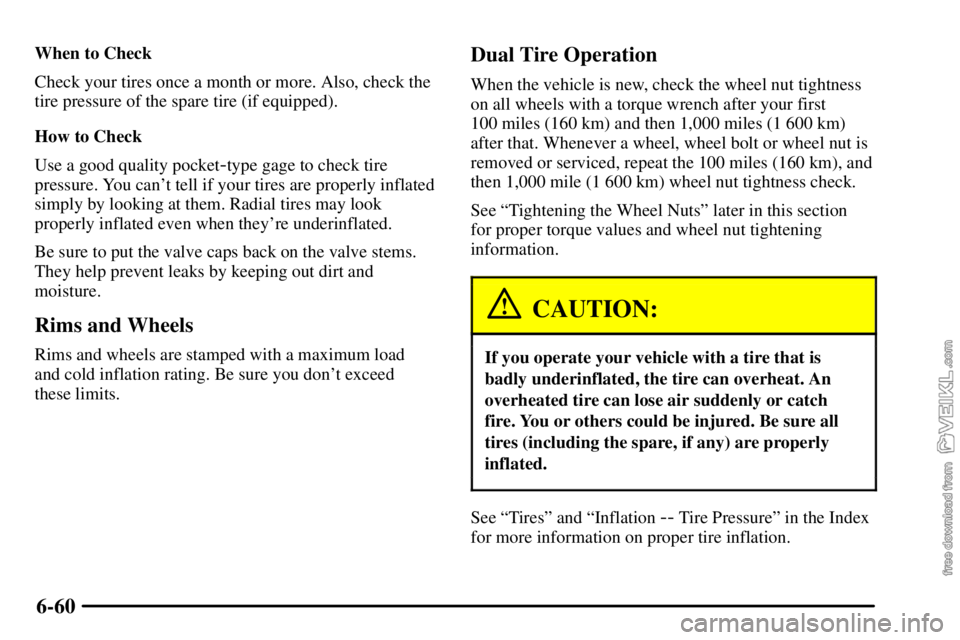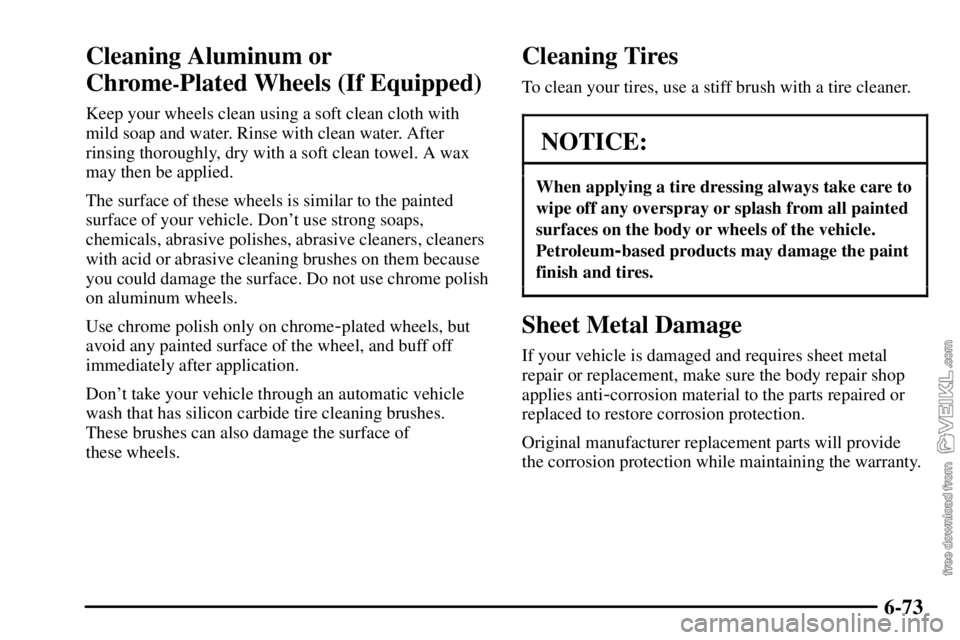Page 314 of 386

6-60
When to Check
Check your tires once a month or more. Also, check the
tire pressure of the spare tire (if equipped).
How to Check
Use a good quality pocket
-type gage to check tire
pressure. You can't tell if your tires are properly inflated
simply by looking at them. Radial tires may look
properly inflated even when they're underinflated.
Be sure to put the valve caps back on the valve stems.
They help prevent leaks by keeping out dirt and
moisture.
Rims and Wheels
Rims and wheels are stamped with a maximum load
and cold inflation rating. Be sure you don't exceed
these limits.
Dual Tire Operation
When the vehicle is new, check the wheel nut tightness
on all wheels with a torque wrench after your first
100 miles (160 km) and then 1,000 miles (1 600 km)
after that. Whenever a wheel, wheel bolt or wheel nut is
removed or serviced, repeat the 100 miles (160 km), and
then 1,000 mile (1 600 km) wheel nut tightness check.
See ªTightening the Wheel Nutsº later in this section
for proper torque values and wheel nut tightening
information.
CAUTION:
If you operate your vehicle with a tire that is
badly underinflated, the tire can overheat. An
overheated tire can lose air suddenly or catch
fire. You or others could be injured. Be sure all
tires (including the spare, if any) are properly
inflated.
See ªTiresº and ªInflation -- Tire Pressureº in the Index
for more information on proper tire inflation.
Page 316 of 386
6-62 Wheel Alignment and Tire Balance
The wheels on your vehicle were aligned at the factory
to give you the longest tire life and best overall
performance.
Proper front wheel alignment must be maintained in
order to ensure efficient steering, good directional
stability, and prevent abnormal tire wear. If you notice
unusual tire wear or your vehicle is pulling one way or
the other, the alignment may need to be reset. If you
notice your vehicle vibrating when driving on a smooth
road, your wheels may need to be balanced.
Tightening the Wheel Nuts
CAUTION:
Wheel nuts that are not tight can work loose. If
all the nuts on a wheel come off, the wheel can
come off the vehicle, causing a crash. All wheel
nuts must be properly tightened. Follow the rules
in this section to be sure they are.
This section lets you know how often to check the
tightness of the wheel nuts on your vehicle and how
tight they must be.
First, use these pictures to decide what kind of wheels
you have.
Page 317 of 386
6-63
Hub-Piloted Type,
8
-HoleHub
-Piloted Type,
10
-Hole
Then, follow the steps below for the wheels you have.
CAUTION:
Never use oil or grease on studs or the threads of
the wheel nuts. If you do, the nuts might come
loose. Your wheel could fall off, causing a crash.
Hub-Piloted Wheels, 8-Hole or 10-Hole
The studs and nuts used with these wheels have
right
-hand threads.
1. With intermittent pilot pads, position a pad at
12 o'clock to center the wheel and reduce run
-out.
2. Put the tire and rim assembly on the axle hub. Install
the outer rear tire and rim assembly so that its valve
stem is exactly opposite the valve stem on the inner
tire and rim assembly.
3. Put on the wheel nuts.
4. Finger
-tighten the nuts.
5. Oil the surfaces between the nuts and washers.
Do not oil the studs or the threads of the nut.
6. Tighten the nuts to 400 lb
-ft (542 N´m) if an 8-hole
stud or 480 lb
-ft (650 N´m) if a 10-hole stud. Use the
following diagrams.
Page 318 of 386
6-64
8-Hole
10-Hole (Front or
Inner Dual Wheel)10-Hole
(Outer Dual Wheel)
CAUTION:
If wheel studs are damaged, they can break. If all
the studs on a wheel broke, the wheel could come
off and cause a crash. If any stud is damaged
because of a loose
-running wheel, it could be that
all of the studs are damaged. To be sure, replace
all studs on the wheel. If the stud holes in a wheel
have become larger, the wheel could collapse in
operation. Replace any wheel if its stud holes
have become larger or distorted in any way.
Inspect hubs and hub piloted wheels for damage.
Because of loose running wheels, piloting pad
damage may occur and require replacement of
the entire hub, for proper centering of the wheels.
When replacing studs, hubs, nuts or wheels, be
sure to use GM original equipment parts.
Page 319 of 386
6-65
CAUTION:
Rust or dirt on a wheel, or on the parts to which
it is fastened, can make the wheel nuts become
loose after a time. The wheel could come off and
cause a crash. When you change a wheel, remove
any rust or dirt from the places where the wheel
attaches to the vehicle. In an emergency, you can
use a cloth or paper towel to do this; but be sure
to use a scraper or wire brush later, if you need
to, to get all the rust or dirt off.
How Often to Check
Wheel tightness is so important you should have a
technician check nut tightness on all wheels with a
torque wrench after your first 100 miles (160 km), and
then 1,000 miles (1 600 km) after that. Be sure to repeat
this service whenever you have a tire removed or
serviced. See ªMaintenance Scheduleº in the Index for
further information.
Page 320 of 386

6-66 Wheel Replacement
Replace any wheel that is bent, cracked or badly rusted.
If wheel nuts keep coming loose, replace the wheel. If
the wheel leaks air, replace it.
Your dealer will know the kind of wheel you need.
CAUTION:
A leaking wheel could fail without warning. A
wheel designed for tubeless tires could be leaking
because it is damaged. Don't use an inner tube or
some other thing to try to stop the leaking. Get a
new wheel of the proper type.
CAUTION:
Without the correct wheel, you may not be able
to stop properly, and you could have other
problems like a tire air
-out. You could have a
collision. If you don't go to your dealer to get a
new wheel, be sure you get the correct one. Each
new wheel should match the original wheel in
load
-carrying capacity, inflation pressure
capacity, diameter, width, offset and mounting
configuration.
Using wheels and tires with higher load-carrying limits
than the original wheels and tires doesn't change the
GAWR or the GVWR of your vehicle.
Page 321 of 386

6-67
NOTICE:
The wrong wheel can cause trouble in bearing
life, brake cooling, speedometer/odometer
calibration, headlamp aim, bumper height,
vehicle ground clearance, stopping distance and
tire clearance to the body and chassis. You could
also have other problems like a tire air
-out.
Used Replacement Wheels
CAUTION:
Putting a used wheel on your vehicle is
dangerous. You can't know how it's been used or
how many miles it's been driven. It could fail
suddenly and cause an accident. If you have to
replace a wheel, use a new GM original
equipment wheel.
Appearance Care
Remember, cleaning products can be hazardous. Some
are toxic. Others can burst into flame if you strike a
match or get them on a hot part of the vehicle. Some are
dangerous if you breathe their fumes in a closed space.
When you use anything from a container to clean your
vehicle, be sure to follow the manufacturer's warnings
and instructions. And always open your doors or
windows when you're cleaning the inside.
Never use these to clean your vehicle:
�Gasoline
�Benzene
�Naphtha
�Carbon Tetrachloride
�Acetone
�Paint Thinner
�Turpentine
�Lacquer Thinner
�Nail Polish Remover
They can all be hazardous
-- some more than
others
-- and they can all damage your vehicle, too.
Page 327 of 386

6-73
Cleaning Aluminum or
Chrome
-Plated Wheels (If Equipped)
Keep your wheels clean using a soft clean cloth with
mild soap and water. Rinse with clean water. After
rinsing thoroughly, dry with a soft clean towel. A wax
may then be applied.
The surface of these wheels is similar to the painted
surface of your vehicle. Don't use strong soaps,
chemicals, abrasive polishes, abrasive cleaners, cleaners
with acid or abrasive cleaning brushes on them because
you could damage the surface. Do not use chrome polish
on aluminum wheels.
Use chrome polish only on chrome
-plated wheels, but
avoid any painted surface of the wheel, and buff off
immediately after application.
Don't take your vehicle through an automatic vehicle
wash that has silicon carbide tire cleaning brushes.
These brushes can also damage the surface of
these wheels.
Cleaning Tires
To clean your tires, use a stiff brush with a tire cleaner.
NOTICE:
When applying a tire dressing always take care to
wipe off any overspray or splash from all painted
surfaces on the body or wheels of the vehicle.
Petroleum
-based products may damage the paint
finish and tires.
Sheet Metal Damage
If your vehicle is damaged and requires sheet metal
repair or replacement, make sure the body repair shop
applies anti
-corrosion material to the parts repaired or
replaced to restore corrosion protection.
Original manufacturer replacement parts will provide
the corrosion protection while maintaining the warranty.